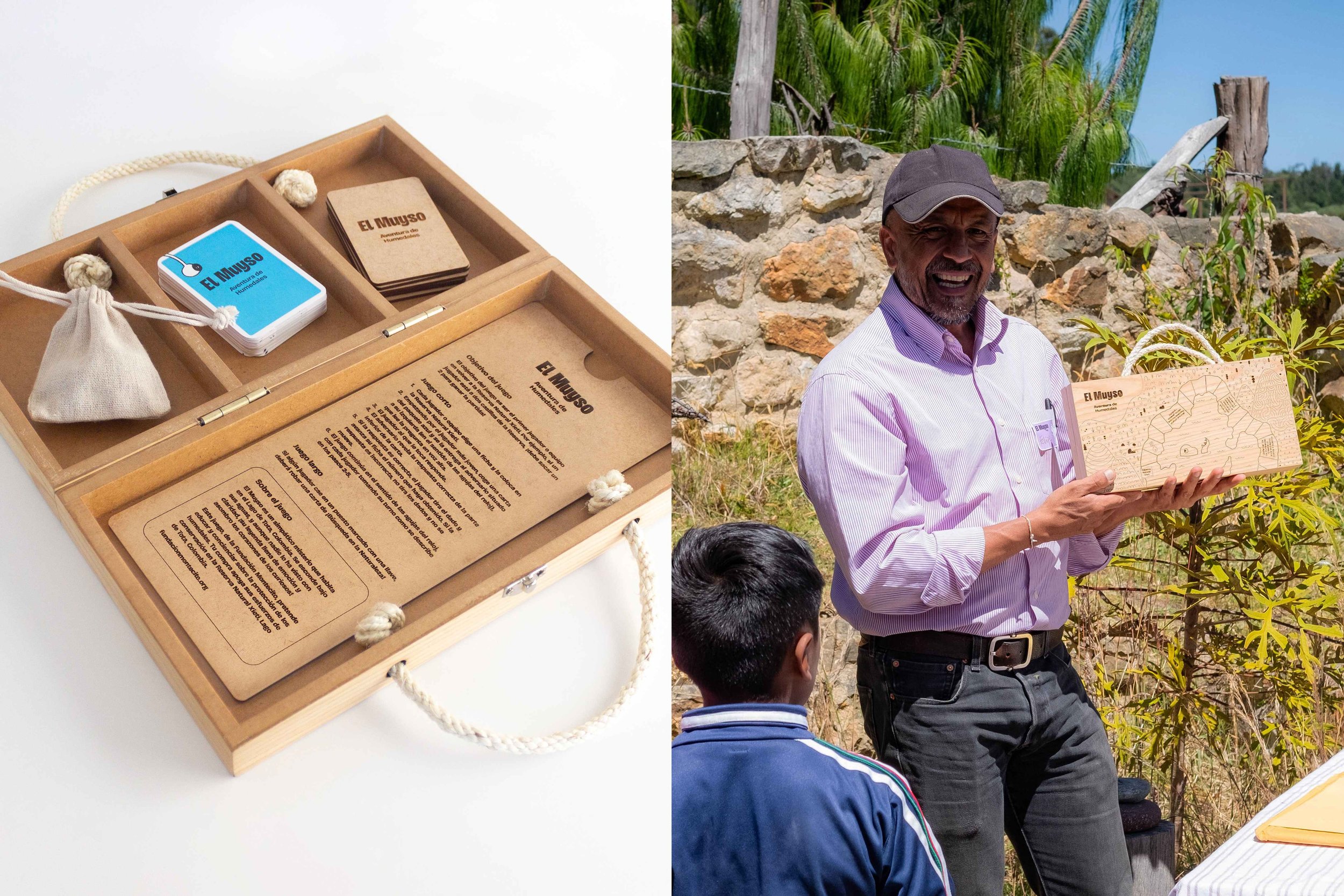Exploring Colombia’s Wetlands and Culture Through Play
El Muyso Game
Industry
Environmental Conservation
Fundación Montecito is a non-profit organization based in Sogamoso, Colombia, dedicated to environmental conservation and cultural education through their two nature reserves. With the goal of fostering a deeper connection between the local community and Lake Tota’s wetlands, we partnered with them to create impactful, educational experiences.
As part of the same 8-week collaboration in Sogamoso, we partnered with Fundación Montecito to explore new ways of engaging the community with Lake Tota's wetlands. Through research, ideation, and collaborative design thinking, the concept of a board game took shape.
The game educates while entertaining to reconnect the community with Lake Tota’s wetlands and its cultural significance—a run of 20 board games sold out in just 2 months.
This work complemented festival branding and educational materials, creating a cohesive strategy for celebrating and protecting Lake Tota’s unique ecosystem.
_
Partner: Fundación Montecito
Woodworker: José Luis
The Question
How might we create an interactive game that brings Lake Tota’s environment to life?
Through home interviews and school focus groups, we learned that children in the community have few games or toys and crave group activities that are both fun and meaningful. Inspired by Felipe’s hand-drawn map and the mythical creature El Muyso, we designed a board game where players navigate Lake Tota, facing conservation-themed challenges. Harm the environment, and you’re banished to El Muyso’s lair.
Crafted with local woodworker José Luis, the game connects culture and conservation, with proceeds supporting the reserve’s preservation. Each box is not just a game; it's a promise to nurture Lake Tota's wetlands.
The board is multi-functional: the box unfolds into the game board, includes handles for easy transport to and from school, and can even be hung as a wall decoration, brightening the bare walls often found in homes.
The Approach
-
We visited children in their homes and schools, discussing nature, conservation and play. We discovered they crave activities that are both fun and informative. Despite their knowledge about nature, their connection to it is limited, with education confined to school and Fundación Montecito.
-
We reflected on our findings to identify what would bring the greatest value to the community while supporting our conservation mission. A game emerged as the ideal solution: engaging, educational, and deeply rooted in local culture and ecology.
-
As a team, we brainstormed game formats and mechanics, blending and refining ideas to create a shortlist. We envisioned a game that was interactive, culturally meaningful, and focused on Lake Tota’s unique biodiversity and conservation challenges.
-
Starting with Jenga blocks and old newspapers, we prototyped gameplay. Inspired by a hand-drawn map from Felipe’s home, we sketched the board and chose wood as the material. Partnering with local woodworker José Luis, we crafted the board and translated wetland-related questions into Spanish. Through testing and iteration, we refined the game to ensure it was both educational and fun.
We laser-cut illustrations into natural wood, preserving its raw, character.
We created templates for easy development of future card packs.
The board offers three gameplay modes, including outdoor-themed quests.
The pieces are abstract representations of native tree species from the reserve.
Observations
With life centered around school and home, children long for engaging, fun activities that also offer learning opportunities.
However, there are no group activities available to children outside school that balance entertainment with education. This lack of recreational opportunities leaves children craving more dynamic, interactive experiences that both entertain and teach them about their environment and culture.
-
Our research revealed that local families had minimal interaction with the lake and wetlands, seeing them solely as resources for survival, such as for farming or fish production. Education about nature was confined to school and the Fundación Montecito’s work. As traditional land relationships and cultural practices fade, children expressed a desire for richer, more engaging experiences.
The solution needed to bridge the gap between learning, culture, and the land they depend on.
Unexpected Adventures
-
We thought we'd get our wooden board prototype quickly, but after countless visits and WhatsApp calls to the woodworker, the first design arrived on Fiona's last day.
We learned that in this new culture, timelines move at their own pace—and flexibility in our plan is the name of the game.
-
We're fast, loud, and a little bossy—and we’re women. Felipe’s mom pointed out how rare our energy is in her community. We learned that our bold approach can be overwhelming, and we need to adjust to the local rhythm.
Our impact
“Your work has improved our educational outreach, increased community engagement, and added a professional touch to our materials.”
Felipe continued to say “The game you designed was a hit! People enjoyed it immensely, and it has become a regular part of our educational programs...
It’s not only fun but also very informative, helping participants learn about our local wildlife in an engaging way.”









